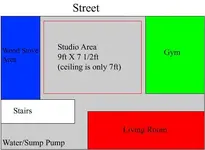J
Jagg76
New member
I have attached a drawing of my basement.
I want to create a studio in my parents' basement (I myself currently live in an apartment). There is only one place where there's room to do this (which is marked in the drawing). In that empty area, the walls and floor are cement and the ceiling is unfinished (wooden beams) and there is a busy street on the wall side. Does anyone think this could work? And if so, where would I go from here as far as building, soundproofing, etc...? I don't want to invest a great deal at the moment seeing as this would be mainly for recording demos for my own work. As long as I get something half-decent for local radio play. (Maybe a $1000 budget for now). Any constructive ideas would definately be welcome!
(Maybe a $1000 budget for now). Any constructive ideas would definately be welcome!
I want to create a studio in my parents' basement (I myself currently live in an apartment). There is only one place where there's room to do this (which is marked in the drawing). In that empty area, the walls and floor are cement and the ceiling is unfinished (wooden beams) and there is a busy street on the wall side. Does anyone think this could work? And if so, where would I go from here as far as building, soundproofing, etc...? I don't want to invest a great deal at the moment seeing as this would be mainly for recording demos for my own work. As long as I get something half-decent for local radio play.
 (Maybe a $1000 budget for now). Any constructive ideas would definately be welcome!
(Maybe a $1000 budget for now). Any constructive ideas would definately be welcome!




 This is the reality.
This is the reality.
